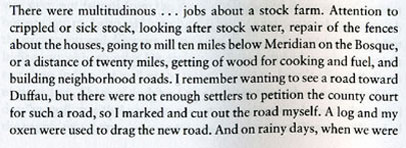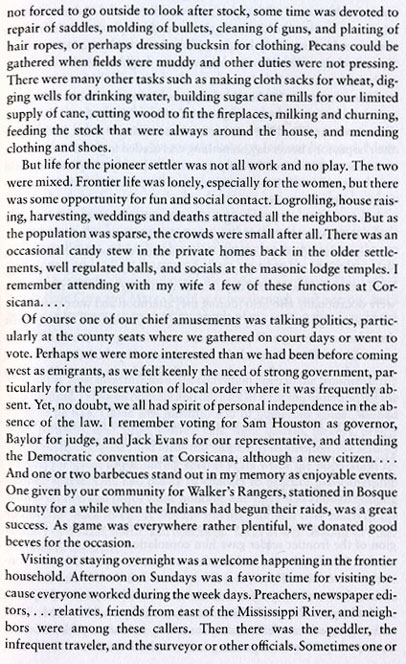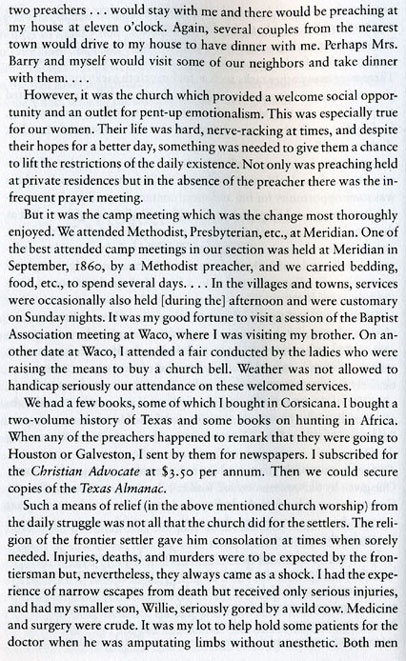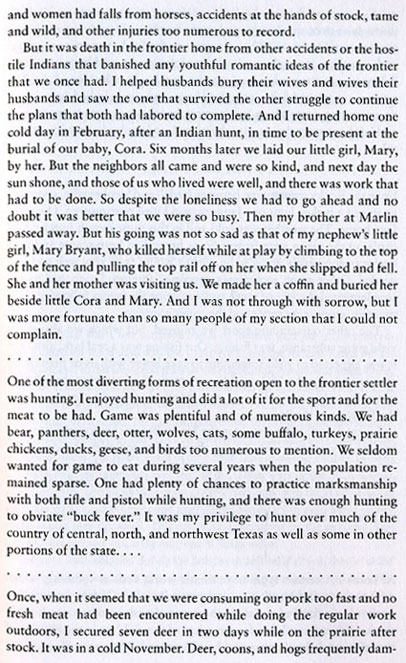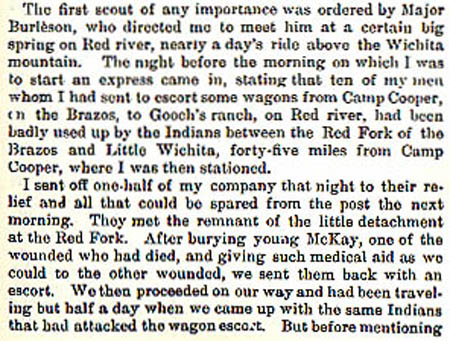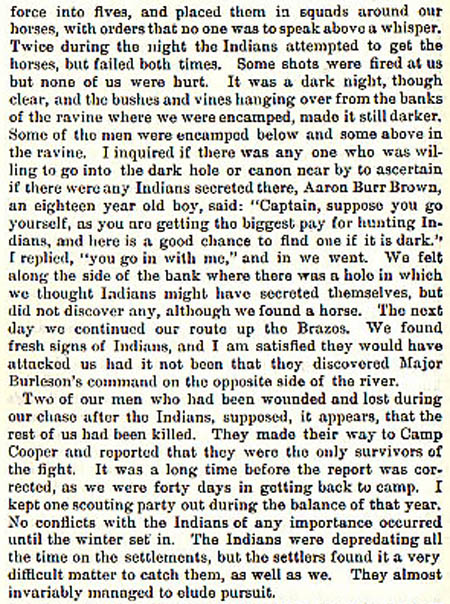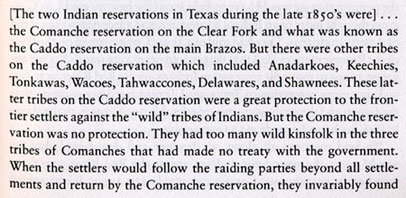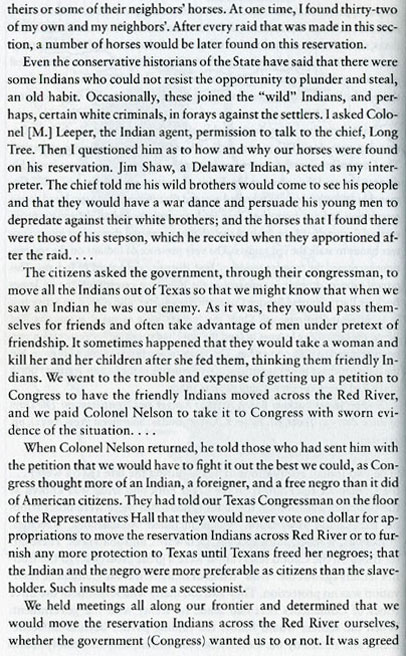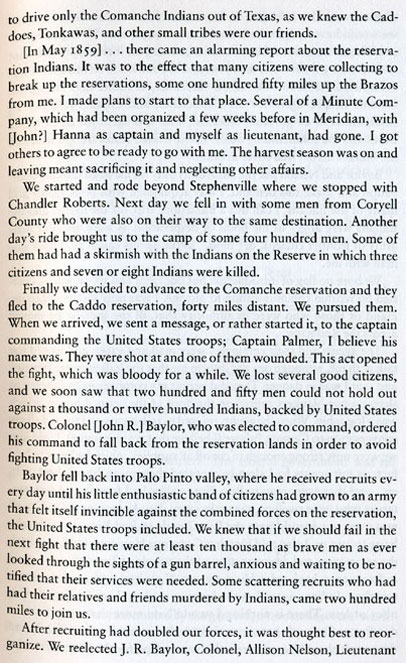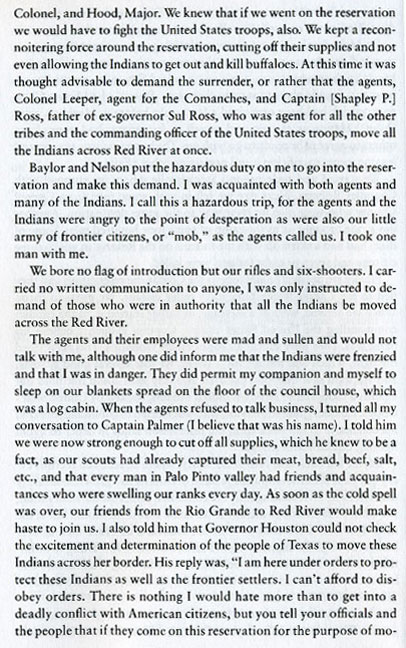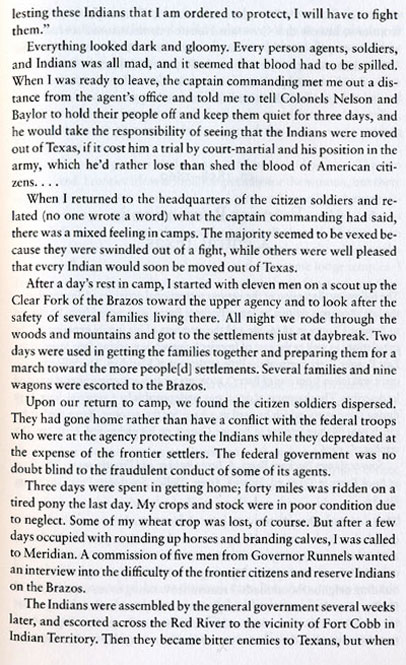Click on a topic to jump to that section.Captain Buck Barry's 1861 Fight | Buck Barry's Life on the Bosque | Barry's Life on the NW Border | Fights of Col. Buck Barry and His Command on the Northwestern Frontier | Col. Buck Barry's Command Encounters Savages Northwest of the Double Mountains of Stonewall County | Buck Barry's Texas Indian Reservations | Ranger Markers at Walnut Springs Park | Col. R.B. (Buck) Berry's Indian Fight in McCulloch CountyCaptain Buck Barry's 1861 FightWe are fortunate to have Captain Barry's firsthand account of his service with the Frontier Regiment, from the book, Indian Depredations In Texas, by J.W. Wilbarger. A badly mauled detachment who had been sent to escort wagons from Camp Cooper returned to Captain Barry's Company. "The sergeant reported Corporal Miller as having acted mutinously. Corporal Miller said that during the hottest part of the contest, while surrounded on all sides in the open prairie and Indians cross firing at them from every direction, he (Sergeant Erhenback) had ordered a retreat, to what he thought a better position. Corporal Miller persuaded the boys to fight it out where they were, as they had several dead horses for shelter, and he called the sergeant a coward, whereupon they attempted to shoot each other, but were prevented from doing by the others. "The fight lasted until the Indians had used up all their ammunition (so they supposed) and fell back. It began at nine a.m. and continued until three p.m., and extended over five miles of open prairie. The wounded men rode such horses as were able to trail, whilst the rest fought around them on foot against four times their number. We learned from some of the reservation Indians that their wild friends lost eight of their warriors in this fight." Captain Barry describes what happened two days later when his Company caught up with the same Indians. "Their force had been increased to about one hundred warriors, and they were making their way toward the settlement. Willie Biffle, who was a long way from the command on the right flank, came in and reported Indian signs. I halted the command and sent twelve men back after the pack mules that had stampeded. They had scarcely gone out of sight over the divide when we heard firing. We hurried to their relief, but not in time to save three of the twelve men from being killed and others wounded. A general fight then ensued. After a short time the Indians began to fall back, notwithstanding they had three to our one. The fight extended over some ten or twelve miles of ground across the divide, and between the Little Wichita and the Red Fork of the Brazos. Whenever we became somewhat scattered in the chase the Indians would turn and check our advance for a while. They were well armed and equipped and wore a great many savage ornaments. The one the chief wore was composed of feathers, stripped from the quills and tied to his hair, as long as there was a place to tie one, which increased the size of his head until it looked like a large wash tub. He was quite a brave man, but we made his hair and feathers both fly. Many bullets were thrown from their course by his shield, and many were embedded in it. A chance shot from the gun of John L. Hardigree eventually just missed the top of his shield and struck his head, but did not inflict a wound sufficient to kill him. As soon as they perceived that their chief was wounded his warriors rallied around him and moved him away. "Many of our men who were on slow horses had fallen behind, but coming up just then with loaded guns they soon set the Indians traveling again. "We lost three killed in this fight, to wit, Thomas J. Weathersby, Lip Conley and Bud Lane. Two men were wounded. We only killed seven of the Indians that we know of. The next morning our horses were so stiff that we had to help them upon their feet. Lieutenant Bushong's horse was unable to stand, and we were compelled to leave him, expecting he would be devoured by wolves, but when we returned to camp we found him there. We buried our comrades with our butcher knives, placing their bodies in a deep buffalo trail, and carrying earth in our blankets to cover them from the nearest bluff, where it was readily scooped out. After we had thus covered their bodies as well as we could with earth, we laid heavy stones on top of all to prevent wolves from scratching them up. This was in July, 1861. We moved a short distance that day, and the next day our spies on the right flank reported they had seen Indians chasing buffalo. We started out for them at once, but only succeeded in running our horses down. Thinking the Indians would follow us, I left two men on good horses on our trail three miles from where we intended to camp, to keep watch, instructing them to remain there until dark. After night they came in and reported that the Indians were following us. That night I divided my whole force into fives, and placed them in squads around our horses, with orders that no one was to speak above a whisper. Twice during the night the Indians attempted to get the horses, but failed both times. Some shots were fired at us but none of us were hurt. It was a dark night, though clear, and the bushes and vines hanging over from the banks of the ravine where we were encamped, made it still darker. Some of the men were encamped below and some above in the ravine. I inquired if there was any one who was willing to go into the dark hole or canon near by to ascertain if there were any Indians secreted there. Aaron Burr Brown, an eighteen year old boy, said. "Captain, suppose you go yourself, as you are getting the biggest pay for hunting Indians, and here is a good chance to find one if it is dark." I replied, "you go in with me," and in we went. We felt along the side of the bank where there was a hole in which we thought Indians might have secreted themselves, but did not discover any, although we found a horse. The next day we continued our route up the Brazos. We found fresh signs of Indians, and I am satisfied they would have attacked us had it not been that they discovered Major Burleson's command on the opposite side of the river. "Two of our men who had been wounded and lost during our chase after the Indians, supposed, it appears, that the rest of us had been killed. They made their way to Camp Cooper and reported that they were the only survivors of the fight. It was a long time before the report was corrected, as we were forty days in getting back to camp. I kept one scouting party out during the balance of that year. No conflicts with the Indians of any importance occurred until the winter set in. The Indians were depredating all the time on the settlements, but the settlers found it a very difficult matter to catch them, as well as we. They almost invariably managed to elude pursuit." Buck Barry's Life on the Bosque
Barry's Life on the NW BorderThe following pages contain R.B. Barry's first-hand narrative of his encounters with Indians along the Northwestern border. (Reprinted from the book, Indian Depredations in Texas, by J.W. Wilbarger).
Fights of Col. Buck Barry and His Command on the Northwestern FrontierAfter the ordinance of secession was passed, early in 1861, as has already been related, Col. Henry E. McCulloch and his forces were assigned to the frontier. Col. R.B. (Buck) Barry, who had charge of a portion of McCulloch's command, was stationed on the northwestern frontier. While camped at Camp Cooper, Col. Buck Barry agreed to meet Major Burleson at a spring on Red River. Consequently he detailed ten men to escort the wagons, which carried provisions and supplies. When the ten men had gone about forty miles, they were stormed by a large number of savages, and eight of their number were wounded. The battle started at nine a.m. and continued until three p.m. when the Indians were supposed to have exhausted their ammunition and left the field. It was afterwards learned through peacable tribes that the savages lost eight of their warriors. Capt. Buck Barry, as soon as he received the news of their situation, dispatched one half of his command to the ranger's relief. During the second day after the above fight, Wilse Biffle reported to Capt. Buck Barry and his command, that he had discovered Indian signs. Col Buck Barry halted his command and sent twelve men back for the pack mules. This was during the hot days of July, 1861. The twelve men were hardly out of sight, when firing started. The remaining command, of course, rushed to their relief. But three of their number, namely: J.J. Weatherby, Tif Conneley, and Bud Lane had already been killed, During the fighting two others were wounded. The savages were well armed, highly painted for war, and outnumbered Col. Buck Barry's men about three to one. Their chief, in accordance with their usual custom on such occasion, was wearing a peculiar head piece somewhat similar to that often worn by a bandmaster. For a long time this chief was able to turn the showering bullets with his shield. But finally the Indian chieftain was wounded in the head, and his warriors rallied to his relief and moved him away. It was not long before a running fight followed with the savages in the lead. For ten or twelve miles, along the divide between the little Wichita and the Red Forks of the Brazos, the rangers followed the Indians. Seven of the savages were known to have been killed, and, perhaps others seriously wounded. The next morning, the horses of Buck Barry's men were so stiff, they were hardly able to stand. Graves were dug with butcher knives for the dead, and they were buried in a buffalo trail. Private McKay who was one of the eight men wounded two days before, also, died and was given a frontier burial. Ref.: Col. Buck Barry's account of his controversy in Wilbarger's Indian Depredations in Texas; also interviewed F.M. Peveler, Babe Williams, John Marlin, Henry Williams, Mann Johnson, W.A. Ribble, and others who were living on the northwestern frontier at the time or shortly afterwards. A searching party was sent out, and Mr. Schriber was found dead and scalped where he had been massacred by the Indians. The above story is from the book, The West Texas Frontier, by Joseph Carroll McConnell. Col. Buck Barry's Command Encounters Savages Northwest of the Double Mountains of Stonewall CountyJune 18, 1863, James Willett, who was in command, S.M. Williams, Hail Woods, who was a substitute for Isaac Sanger, (who ran a store, first at Weatherford, and later assisted in the establishment of the well-known Sanger Bros. store of Dallas, Waco, and Ft. Worth), Maliki Wood, A.M. Williams, Gordan Bedford, Geo. Dodson, Granger Dyer, "E" Gilbert, Morgan, Pete Littlefield, and approximately four others, discovered Indian signs and their trail was followed in a westerly and north-westerly direction until darkness. Early during the morning of the succeeding day the trail was followed for about four miles and the savages encountered at a point about 10 miles northwest of the Double Mountains, near the edge of one of the large brushy thickets which grow so abundantly in this section. For a short time the savages made a stand. But they soon retreated. One savage was singled out by Babe Williams. This Indian dodging in his own mysterious way, ran in between Williams and James Willet, who was in command, and who was at the time engaged with the chief. Babe Williams ran up and fired his revolver at the chieftain, who had already wounded Willett's horse. At the crack of Williams' gun the chief fell to the ground. The savages were now rapidly retreating, but during the fighting four of their number were known to have been killed and perhaps others wounded. James Willett himself, was also wounded, but soon recovered. Note: Author personally interviewed Babe Williams, who was in the fight and, shot the chief. The above attachment was assigned to Col. Buck Berry's command, and belonged to the Frontier Regiment. The above story is from the book, The West Texas Frontier, by Joseph Carroll McConnell. Buck Barry's Texas Indian Reservations
Ranger Markers at Walnut Springs ParkJames Buckner "Buck" Barry, C.S.A. Historical Marker
|
||||
|
||||
